Tetouan: Art I See
Introduction
My first post on my month in Tetouan, a small northern city in Morocco, concentrated on what I accomplished as an artist. The team of ex-pat Americans who ran Green Olive Arts (GOA) deserve accolades for making it possible. That post–Tetouan:Art I Make–can be read at: http://www.scottponemone.com/art-making-in-tetouan/
But the story of my residency would be incomplete without presenting the other visiting artists who shared my time at GOA. Our stays were not identical. While Holly Woodward, Jan Davis and Glen Rogers all arrived when I did, they left two weeks into my four-week tenure. In their place came Corina del Carmel Tamez-Hibbard, Sarah Gross and Colette Fu. Those three continued on after I left. This post will allow me to introduce each of them and show what they made at GOA.
The folks at GOA were excellent in connecting us to Tetouanese. Rachel Pearsey, GOA’s Director of Studios and Women’s Initiatives, led a tour of resident artists to Dar Sanaa, the School of Arts and Crafts, and the Ensemble Artisanal, a co-op where craftsmen and women open their studios to visitors. She also set up an Islamic geometry class with a graduate of Dar Sanaa. And she introduced us to a photographer who guided us through the ancient medina at midnight. He, in turn, brought us to two venues for music deep in the medina.
I’ll also take you to Chefchaouen, a well-preserved hill town renown for its brilliant blue walls. Accompanying me on my one day trip outside Tetouan was David Brown, a longtime friend and retired Washington Post medical reporter.
Fellow Artists
I asked each of my fellow GOA artists to discuss what their intentions were in applying to GOA and whether they met those goals while there. (You’ll note that a number of fellow artists reside or hail from Spanish-speaking countries. Being fluent in Spanish is a great advantage in Tetouan, part of a former 20th-century Spanish protectorate in northern Morocco.)
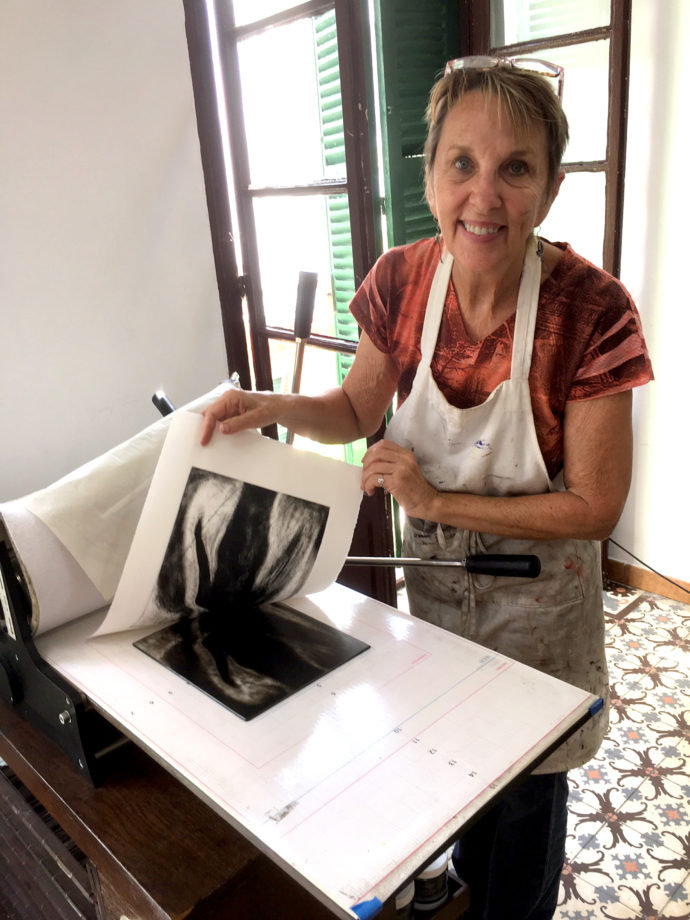
Glen Rogers lifting a monotype from the press at Green Olive Arts. (Courtesy of the artist)
Glen Rogers
A resident of San Miguel de Allende, Mexico, Glen Rogers is an accomplished artist with a strong suit in printmaking, particularly monotypes. Her website is glenrogers.com. She made great use of the press at GOA. Here is her response to my question:
I’ve done a number of artist residencies over the years, and I always find that something shifts in my artwork–whether it’s the use of color, the change in imagery, or a new inspiration to be found. I chose to visit Morocco because I was intrigued by Moorish design, the textiles, the colors, the crafts, etc. My idea of what I would create at the Green Olive Residency totally changed once I got there.
Archetypal symbols have been the main focus of my work for the past twenty-five years so it was a surprise to me that the figure emerged after so long. As a woman artist brought up in the Western World (and a feminist), I couldn’t help but notice how the Islamic women dressed with their head scarves and djellabas fully covering their bodies. There was a certain anonymity that intrigued me about these women as I walked through the streets. I held no judgement, but rather a curiosity about my Moroccan sisters. Working at the etching press, I created a series of monotype prints entitled Anonymous in Morocco.

Glen Rogers, Anonymous in Morocco, 9 monotypes, each image 12″ x 9″ (Courtesy of the artist)
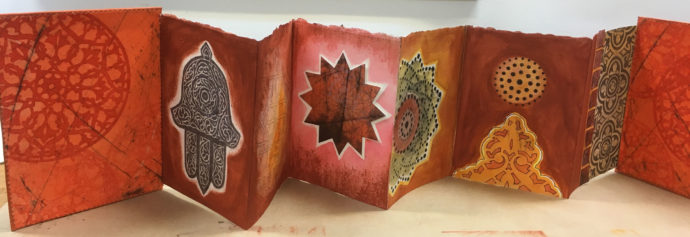
Glen Rogers, accordion book, mixed media. (Courtesy of the artist)
She later emailed me this: “I also did this accordian book. I collaborated with the leather worker for the covers, and, inspired by the decorative elements of Morocco, I used various hand-cut stencils purchased in the medina.”

(Courtesy of Jan Davis)
Jan Davis
Also a resident of San Miguel de Allende, Jan Davis is a former college librarian who conducts an international business as an internet researcher. Her firm is Blue Sage Research and a link to her website link is here. This is her response to my question:
I went to GOA with the intention of finishing six short stories I started years ago. I had been married to a Moroccan man and spent many months living with his family in Marrakech.
I did indeed finish the short stories. I believe one reason to tell stories is to evoke the compassion that already exists in the reader or listener. Via storytelling, I wanted to share parts of my “Moroccan life” that were challenging and endearing at the same time. Morocco had touched me deeply, not only the country’s charm, smells, colors, and culture, more importantly, the very kind and friendly Moroccan people. I was a little hesitant to go back several years later … thinking that part of my life married to a Moroccan was over and best to keep those memories just that … memories.
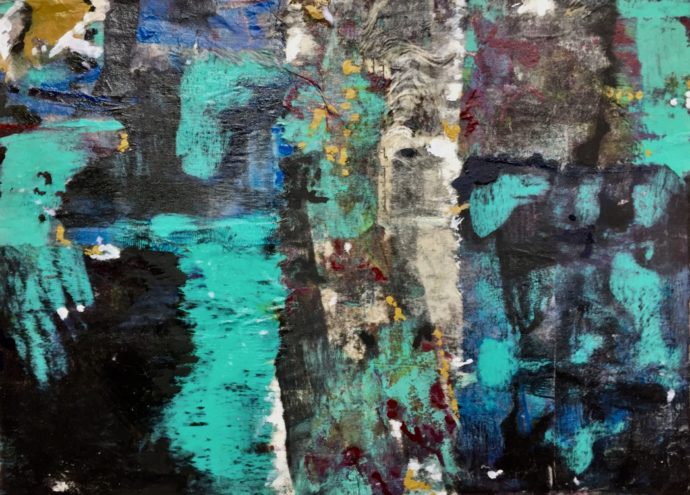
Jan Davis, mixed media artwork. (Courtesy of the artist)
But back in Tetouan I felt and home.
The other wonderful part about being at the GOA was that I allowed time to “play” in the studio. Since I still work for a living, I rarely allow myself the time to be creative. I started by using the gelli plate as a base for painting mulberry paper. From that paper, newspaper, and more acrylic paint I created several small paintings that will serve as “pages” to separate each short story when I eventually self-publish it. I’ve been encouraged to write more Morocco-related short stories….
I absolutely loved my time at the GOA. The founders, Rachel, Jeff and Peter were so supportive, caring and organized. I loved the studio space, the added tours and opportunities to meet the locals. I also loved getting to know my fellow residency-mates!
I’d go back again in a heartbeat.
Holly Woodward

Holly Woodward (Courtesy of Holly Woodward)
Holly, resident of Costa Rica, shared my GOA studio for two weeks. While she doesn’t have a website, she said, “I post art mainly on Facebook, sometimes on Instagram, and thoughts on Twitter, all under my name plain and simple.” She added that her writings can be found online. Here are thelinks to Love Trouble in Literal Latté and to Sex for Beginners in Red Fez.
She provided a statement on what motivates her creative efforts:
I am interested in secrets, dreams, riddles and contradictions. I am fascinated by the way people change, which is a magic enacted sometimes by oneself and often by another on one.
I am struck by a subject like the Hubble telescope photos, and I will paint inspired by those images. Other series riff on snakes or vine, or clouds. In these, and even in the deep space images, I am moved by the transience of things, for in deep space we gaze into our past.
And she sent this response to my question about what she hoped to accomplish at Green Olive Arts:
I thought I would play it by ear, and wanted to do something about gardens and pools, water and reflection, or the seaside. I didn’t manage to see either. I was hoping for more bird sightings. I started by writing a fairy tale about the wind, which was fun, and I wrote a story about the Garden of Eden, and used one line from it in that small collage of words pencilled.
I think I should have brought pen and bought ink and acrylics, and worked with what I am used to, now. But I wanted to try a lighter medium, mainly for the weight limits on the small flights.
I think what I took away that will always stay with me is the light at the end of the day, with birds circling up over the city, and cats on roofs returning to the prowl.

Holly Woodward, watercolor, ink and collage. (Courtesy of the artist)
Corina del Carmel Tamez-Hibbard
Born in Monterrey, Mexico, Corina del Carmel was my studio mate for my second two weeks at GOA and spent another three weeks in Tetouan after I left. To visit her website, click here. As part of her online artist statement, she wrote: “My oil and mixed medium paintings are figurative, detailed and surreal with elements of Magic realism from the tradition of Latino American writers and visual artists.” Here is her response to my query:
My intention in GOA was to experiment with two very different kinds of paper: Yupo synthetic paper and multimedia art board. Both allow the use of oil and water mediums to paint and to develop ideas from my impressions from my trip to Andalucia, Spain, and Tetouan, Morocco. Both are connected by history, conflicts, conquest and cultural exchange though centuries. Tetuan was call “Granada’s daughter.”
Through sketches and drawings I like to play with space and perspective in my art, although the human figure has always been the main source of inspiration in my artwork, not just as a form but also as multi-dimensional being.

Corina del Carmel sits before her painting inspired by Spanish flamenco dancers (right). Her mixed media artwork “Puerta” is shown unfinished above and finished below. (Photo by Colette Fu)
Tetouan’s medina (UNESCO World Heritage site and UNESCO Creative Cities Network in the area of crafts and folk Art) offered me many layers of inspiration from the cultural and visual, and from intensity of everyday life. My first two projects were a first impression of the medina and its labyrinthine paths on multimedia board using charcoal, graphite and oil paintings. And a painting from a drawing I did of flamenco dancers I saw in Cadiz, Spain. I used the vibrations of complementary colors to express the intensity of the dance. This work was made with watercolors and oil paintings on Yupo paper, a 100% polypropylene nonporous paper that allows paint to move freely on the surface and pigment to remain true and vibrant.
The pattern and textures of the medina were projected in my other two projects. In the first one, the image from behind of a woman on a stone path made with common round patterns of the many pathways of the city. And influenced by the work of the artist I share my studio for a couple of weeks Scott Ponemone, I left the background space white–a challenge for me–but this created a more intriguing painting and less narrative.
And the other painting was inspired by the old doors and wall textures of the medina. In this panting I use oil, acrylic and watercolors on Yupo paper. My last artwork still needs more work to be finished. I continued using the patterns, the labyrinth and the people of the medina of Tetouan to create an impression of my view and experience of Tetouan
During my five weeks in Tetouan I created five artworks, but my time there gave me more ideas to bring home with me than was I was able to express.

Sarah Gross glued traditional Moroccan mosaic pieces onto the soles of shoes. (Photo by Colette Fu)
Sarah Gross
Sarah is Assistant Professor of Ceramics at the University of Kansas in Lawrence. After her Green Olive Arts residency, she headed to Rome for a residence at C.R.E.T.A. (Ceramics, Residencies, Exhibitions, Teaching & The Arts). That program is geared to ceramists. In Tetouan she chose to explore other media. Or as she wrote me:
I would say my intentions were to connect with local artisans and learn about craft traditions outside of my normal ceramics practice. GOA was great for connecting me with metal and leatherworkers and I was able to make work both as an artist/crafts person and as a designer where I had my ideas executed by other people.

Sarah Gross exhibited these tassels at Green Olive Arts. She worked with metal craftsmen at Ensemble Artisanal cooperative. (Courtesy of the artist)
Colette Fu
Colette Fu is a specialist in pop-up books. But “books” maybe a misnomer because some of her efforts are installation-size. Her website is https://www.colettefu.com. Seek out her animations/videos to watch her projects unfold. The following is her response to my question:
I wanted to study under a local metalsmith, learning punch-cut brass and copper work, as I had seen in Moroccan sconces and lanterns from a previous trip. I wanted to merge Chinese minority designs and motifs with those found in the area. I ended up working with two metalsmiths at the co-op and Dar Sanaa.

Colette Fu with a copper shield (20″ in diameter) that Tetouan craftsmen helped her realize. (Courtesy of the artist)
Tetouan
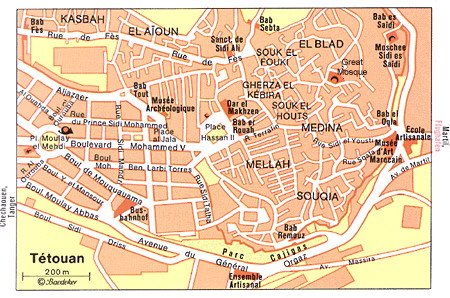
Tetouan is about an hour’s drive southeast of Tangier, Morocco’s northernmost city. It was founded in 1484 by Muslims and Jews fleeing the Spanish re-conquest. (An earlier Merenid city was destroyed by Spain in 1399.) But Spain has a strong influence in today’s Tetouan, once the capital of the Spanish Protectorate, which stretched across most of northern Morocco from 1912 to 1956.
As the map of the heart of Tetouan shows the city is really two cities. The straight boulevards on the west side were the product of Spanish control. The winding alleys to the east indicate where the ancient medina is.

Photos by Scott Ponemone
Yet today’s Tetouanese flow freely between both worlds. Tradition and modernity exist side by side. The top photo was taken just inside the medina where a produce and seafood sellers congregate. Just a few blocks to the south is Boulevard Mohammed V, a broad pedestrian way lined with cafes. I was surprised to see a portrait sketch artist in a Muslim country, given that the religion shuns representational imagery.
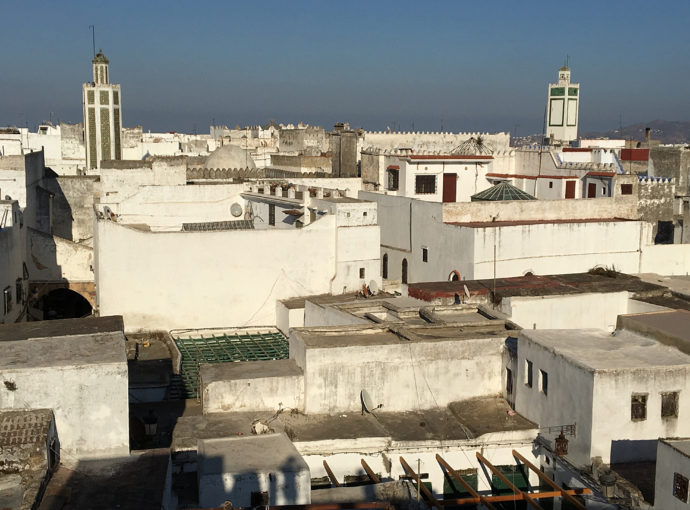
No buildings in the Mmedina rise higher than the minarets. (Photo by Scott Ponemone)
The draw of Tetouan is not grand monuments like those can be found in the imperial cities of Fes, Maknes and Marrakech. What made Tetouan an UNESCO World Heritage site is its medina, which is largely untouched by tourism. You have to look long and hard before you come across a carpet shop.
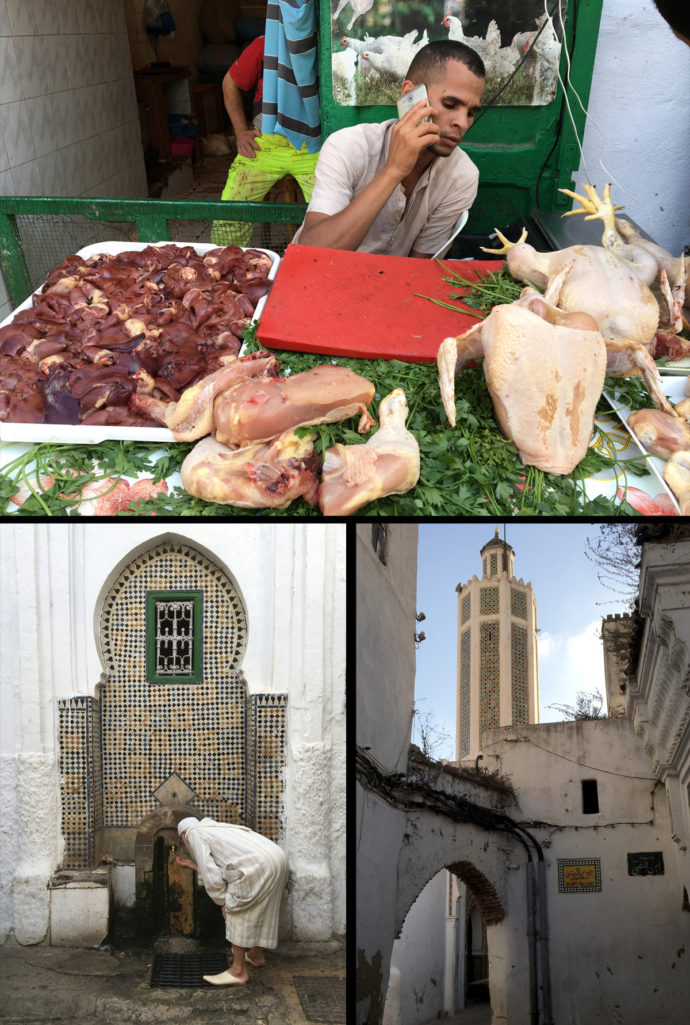
Photos by Scott Ponemone
In the medina chickens are still butchered on site; the mosques are still off limits to non-Muslims; and the ancient neighborhood fountains still quench the thirst of passersby.
Midnight in the medina
Walking in the medina was initially a little off-putting, but not because of fear of crime. It was just that the bustle of the market areas, the narrow often twisting lanes and frequent arches overhead made navigating by landmarks difficult. Yet by the time I left Tetouan I negotiated the medina solo late at night. That wouldn’t have happened if I hadn’t met Abdel Karim el Kamli.
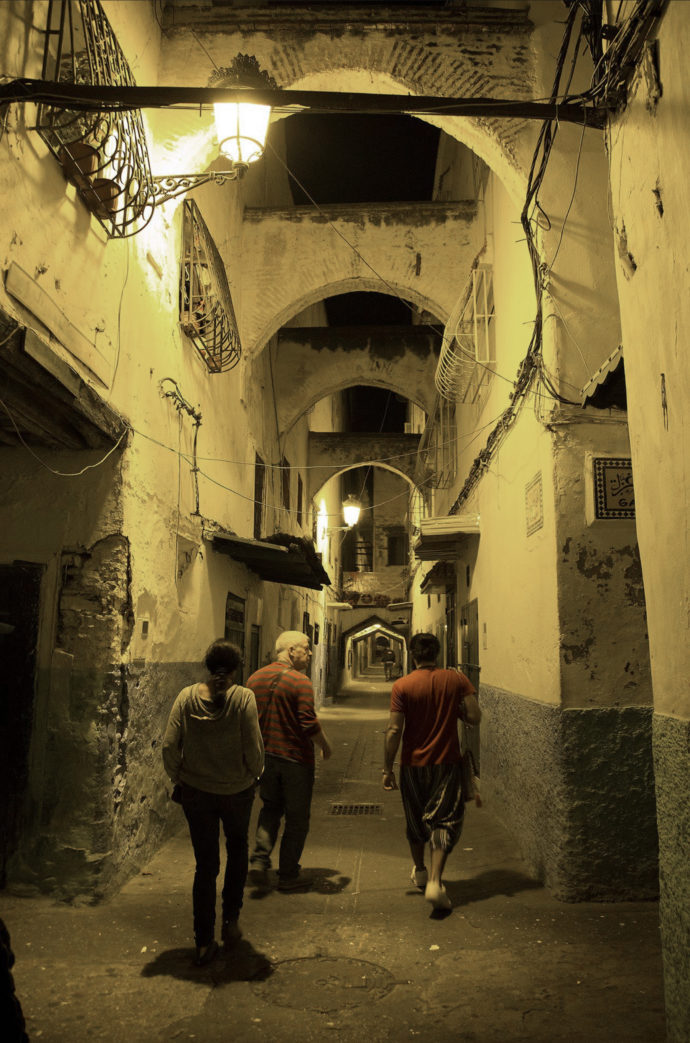
Midnight Medina walk led by Karim el Kamli (right), myself in the center and Corina del Carmel (left) (Photo by Colette Fu.)
Karim led Corina, Colette and myself on a midnight medina tour organized by GOA. Upon entering the medina that night, he first taught us how to read the pavements. He pointed to the stones running down the alley midline. If there are three parallel rows of stones, he said, then you’re on a principal route that will lead to a gate (bab) to exit the medina. If there are two rows of stones (look carefully at the photo above, between Karim’s and my arms), then the alley will connect to a principal route. But if there’s just one row of stones, you’re heading for a dead end.

Abdel Karim el Kamli and the poster advertising his 2017 exhibition of his medina photographs. (Courtesy of Abdel Karim el Kamli)
A native of Tetouan’s medina, Karim was the perfect guide. He showed us how each neighborhood had a cluster of a mosque, a hamman (bath) and a bakery. He pointed out doors to homes that had two places to knock, one for men and one for women. When we came upon a series of six arches, he said that that indicated we were entering the mellah or Jewish quarter. (Few Jews still live in Tetouan. Most left when Israel became independent.)
Before our Midnight tour concluded at 2 in the morning, we enjoyed an impromptu mini concert by three men who love to perform traditional Gnawa music, which a mixture of African, Berber and Arabic religious songs and rhythms. The above snippet was taken in their tiny dark clubhouse, barely large enough for the musicians, Karim and three GOA artists.
On a subsequent evening Karim took us to another part of the medina, not far from the tannery, where in an open-air space maybe 20-feet square an acoustic jam session was in progress. Three guys on guitar and one with a beatbox played and sang Spanish and Arabic songs. On a return visit, a sax player joined in, and a young woman, with the encouragement from the audience, added her forceful voice.
Wandering the medina at night is dear to Karim’s heart. In fact, he made a black-and-white photographic essay of the Medina that was exhibited at Dar Sanaa. He chose the quietest time to shoot–3 a.m.–when he could study the geometry of the medina under the hush of the alley lights. He used no flash; nor did he have a tripod. He took us to several of the places he photographed. I started to see the medina through his eyes.

Karim el Kamli, Tetouan Medina, digital print, 45×30.5cm, signed. (Courtesy of the artist)
When I next saw him, I stressed that I was really interested in seeing his photographs. He sent me about a dozen images to my phone via WhatsApp. I studied them and focused on two that intrigued me. So the next time we met, I stressed my desire to see the actual photos. He seemed a bit surprised. Yet he led me into the medina to his home. I waited outside until he said it was OK to enter. His father greeted me and soon served tea. Karim meanwhile headed upstairs and started to bring down shrink-wrapped framed photos. None seemed to be ones I particularly wanted to see. So he brought more, but this time pairs were wrapped in newspaper. Soon there was a pile of torn paper on the floor. I pointed out that none were signed. His reasoning: Everyone in Tetouan knows he’s the only photographer shooting in black and white. Eventually I spotted one of the two I was hoping to see. Unfortunately it was not quite in focus; blame it on the lack of tripod. Yet another that didn’t catch my eye as a small digital image was perfect full size. I immediately purchased it and left with his framed photo under my arm.
The next morning I bought it to my Green Olive Arts studio and messaged him to kindly drop by. Because I wanted Karim to sign it, I took the photo out of the frame. (That needed to be done anyway because the framer didn’t use a mat to keep the photo away from the glass.) So Karim came by and signed the photo as you can see. In return I handed him back the frame, the glass and the backing board. The photo fit safely inside a watercolor portfolio that I had with me.
Karim works for a German cable company. At the same time he’s trying to establish TAKKLIDI, his own brand of Moroccan-inspired goods to sell on Etsy. In an email to me, he said that TAKKLIDI “was created to rebirth traditional handcraft in the historical medina of Tetouan, in order to take the craft to the next level. TAKKLIDI is not just a brand, it’s a way to express the art of tradition handcraft through modernity.” Currently on Etsy are two TAKKLIDI items: a hoodie and a cellphone case.
DAR SANAA
Located just across the busy boulevard from Bab el-Okla, a gate at the southeast corner of the medina, is Dar Sanaa, the school for traditional crafts. Thanks to a tour by GOA’s Rachel Pearsey, I first got to see students as young as eight learning to draw and paint Islamic geometric designs. Then we entered a room where wood carving was practiced. In another room one youth was hammering thin strips of brass into wood, while another was fashioning pieces of abalone for marquetry. Then there was a studio for plaster carving and a studio for making ceramic pieces for mosaics. In another room a woman was working on a piece of traditional Tetouan embroidery. Elsewhere a metal worker was hammering designs onto brass hands of Fatima.
Here’s a selection of photos from that visit:

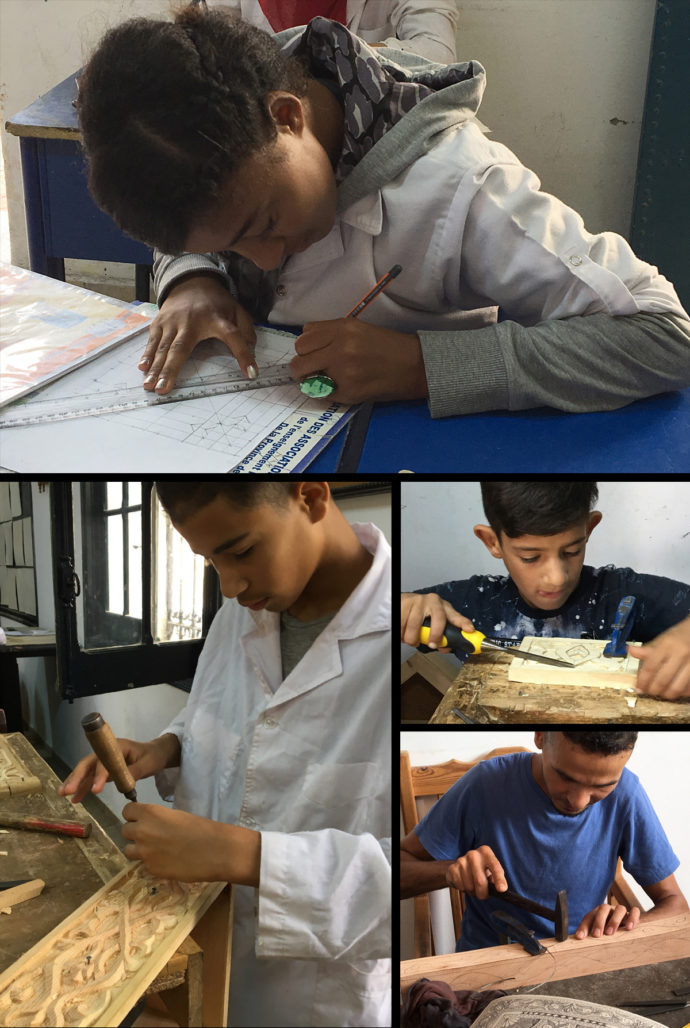

Photos by Scott Ponemone
FREAKY

Mohamed “Freaky” Benyaich (Photo by Scott Ponemone)
At the end of my second week in Tetouan, Green Olive Arts held an open house. One of the visitors was a convivial gentleman who introduced himself as Mohamed Benyaich “but everyone calls me Freaky.” We had a lively chat. He said he was an artist and he invited me to his studio, but not that weekend as he had to go to Tangier, where he had a gallery event. He gave me his card with an address, and then he circled on my medina map where that was. He said to enter the medina at Bab Fes and take the first right into the alley past the pharmacy. And he assured me that, if I couldn’t find his studio, just ask people where Freaky lives. “Everybody knows Freaky,” he added.
Because I hesitated to ask anyone, my first attempt failed. On my second try I waited in a blind alley until a man finished his prayers, rolled up his mat, and went to sit with friends. I showed him Freaky’s business card and asked him where the alley Derb Paes was. He then led me to a coffee-bean seller, who took me to Freaky’s place. (It turns out Freaky’s card had the wrong address number on it.)
Luckily Freaky was home and invited me in to his quite cramped two-story space. His art was everywhere. As he made me tea, I admired a large unfinished canvas of the Last Supper. Jesus and all of the Apostles had oversized hands, a signature Freaky attribute.
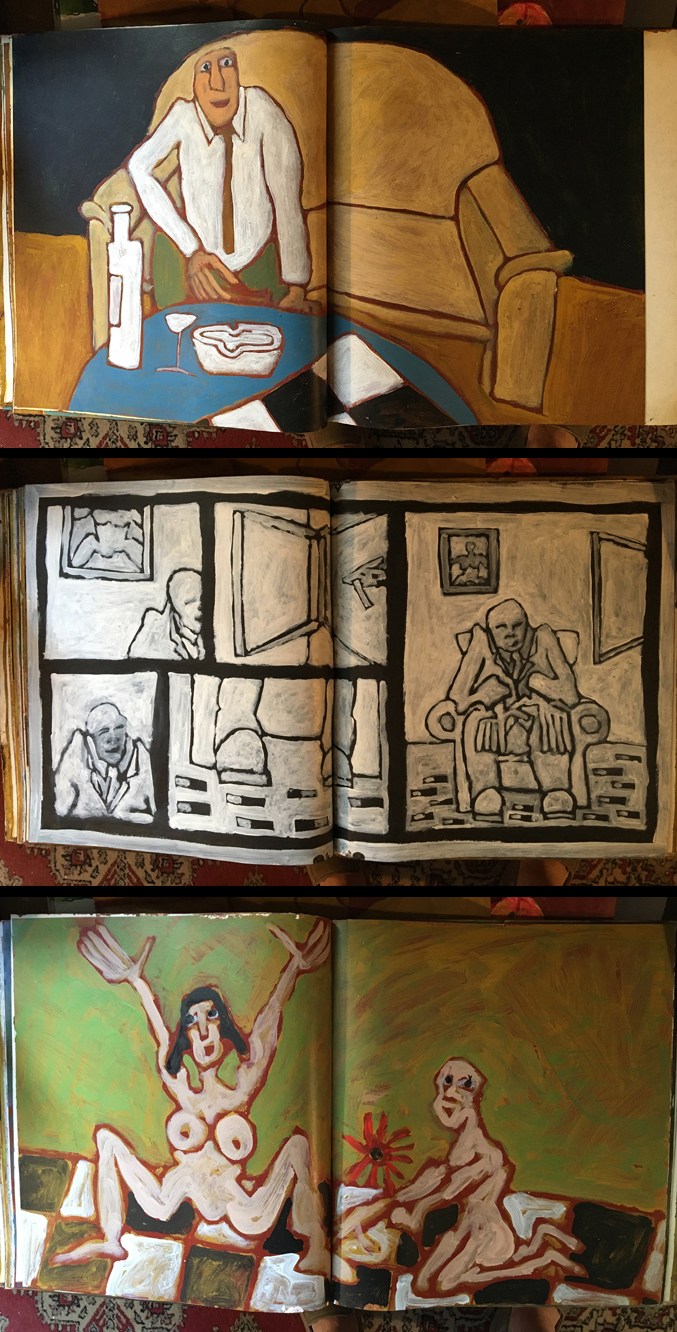
(Courtesy of the artist)
Upstairs he handed me what used to be a wallpaper sample book. Around 2006, he painted the cover and each page. It was an encyclopedia of Freaky. He allowed me to photograph it. Here are three spreads from the book. If I had a larcenous side and if Freaky had turned his back, I would have made off with it. It was that fetching.
Chefchaouen
My one day trip during my four-week GOA residency was to the hillside town of Chefchaouen, noted in my Moon guide to Morocco as “one of the prettiest towns in Morocco…. The narrow blue passages give way to wide squares where the historic Andalusian influence on the town is easily notable….” As shown in the photos below, Chefchaouen blue is everywhere in its medina. The town’s attractiveness earns it a place in many guidebooks. The downside is that Chefchaouen’s medina is tourist savvy. If carpet shops are hard to find in Tetouan, they’re seemingly everywhere in Chefchaouen.

Photo by Scott Ponemone
This shot was made from atop the tower in Chefchaouen’s fortified casbah. Note how the town sits below the slopes of the Rif Mountains.
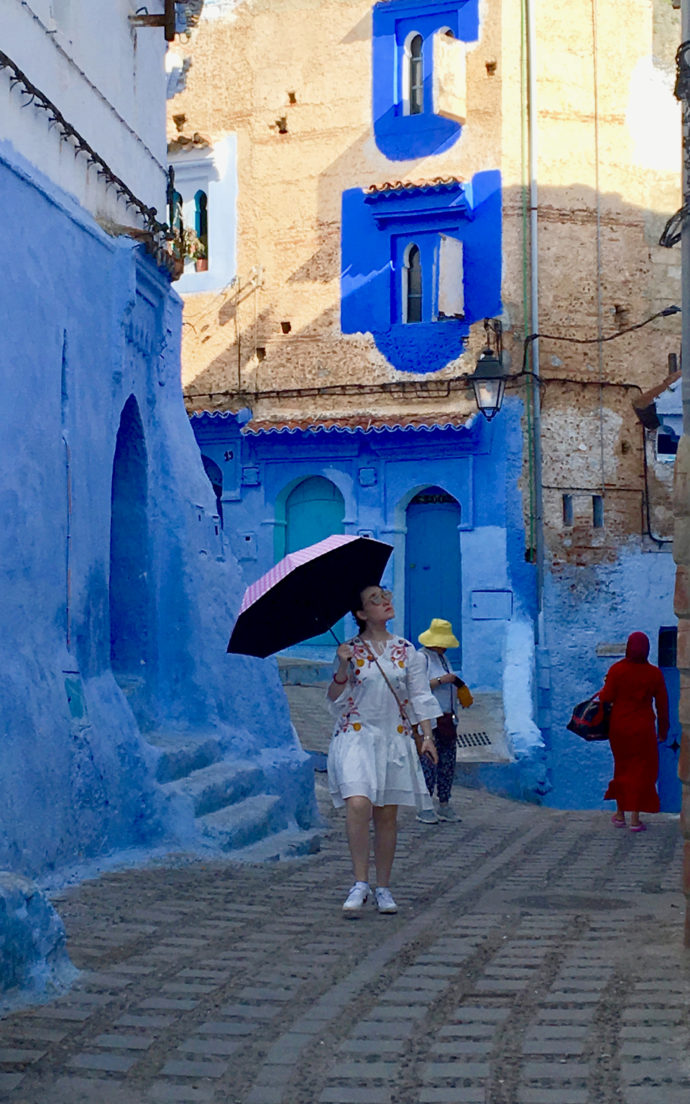
The Chefchaouen blue can be rather startling. (Photos by Scott Ponemone)

CATS
Feral felines were just about everywhere in Tetouan and Chefchaouen. They seem to mark out their territory throughout the towns, whether in a planter along Tetouan’s pedestrian street, everywhere in the fish market, or a porch in Chefchaouen. Most are scrawny, no doubt full of parasites. Some seem to have patrons who leave handfuls of kibbles and a dish of water. (Dogs, by the way, were quite scarce in Tetouan. I only routinely saw a shepherd with its owner on the streets near GOA.)

Photo by Scott Ponemone
David Brown, a travel writer and retired medical reporter for the Washington Post, joined me in Tetouan and Chefchaouen when he wasn’t traveling further south on search of a story. Here he is the Tetouan’s medina. (Even Tetouan had a few blue walls.)
I couldn’t resist doing a video of this orange and white mother cat and her litter playing on a stoop in Chefchaouen. Please click above to get a link to view the video.
CARPETS
I admit it. I did find a carpet shop in Tetouan. Needing runners for my narrow second-floor hall, I brought along a shoelace on which I had tied a knot toward one end. It served as my measuring device. It was tied to indicate the maximum width that the hall could take.

Photo by Scott Ponemone
Here is the salesman checking the inventory numbers on the two kelims from the Berber Zanafi tribe that I chose. During my three previous trips to Morocco (1979-85) I hadn’t seen anything like these. I found the tight weave of camel wool and cotton and the playfulness of the patterns immediately addictive.
Bees
Moroccans have a powerful sweet tooth. Bless them. When pastries are displayed in open-air shops in the medina, what looks a distance like raisons atop buns may well turn out to be bees. Well, in Chefchaouen I came across what looked like sugar-coated chickpeas. And bees defied anyone from tasting them. Please click to get a direct link to view the video.
Trackback URL: https://www.scottponemone.com/tetouan-art-i-see/trackback/


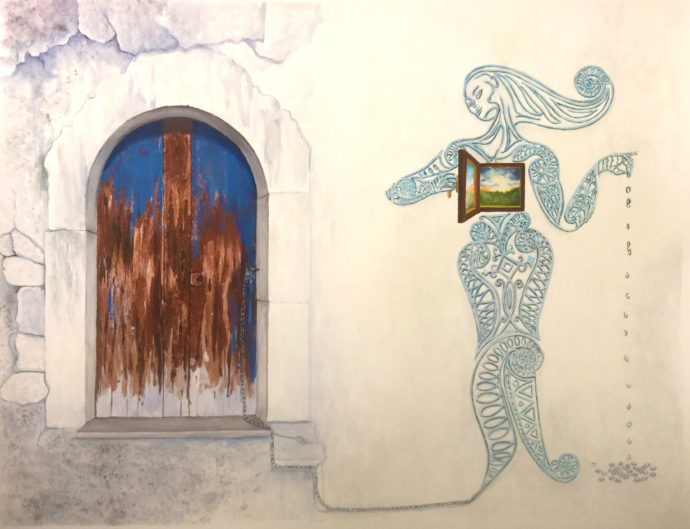
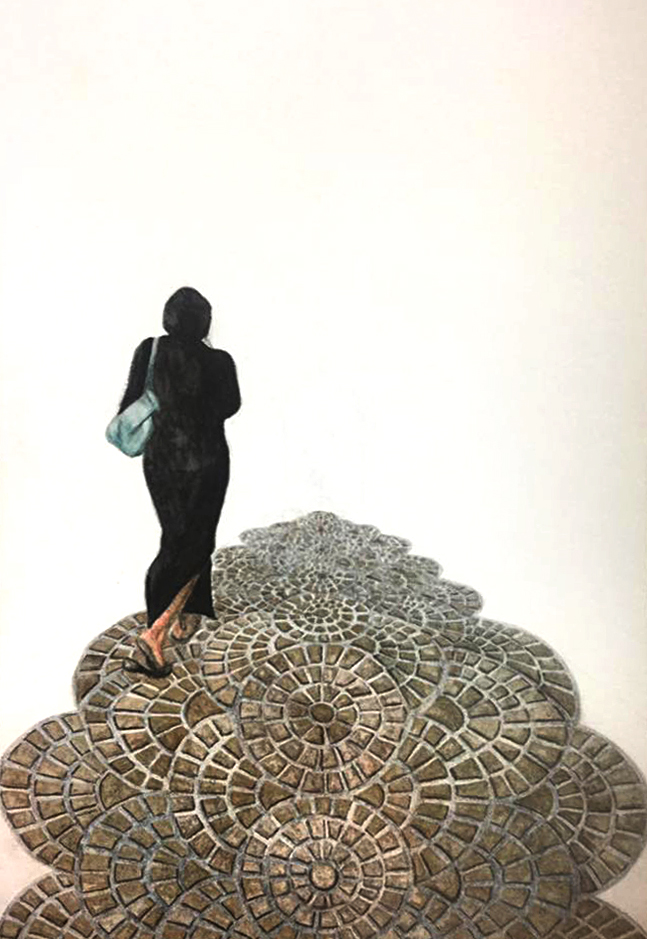










Amazing, fascinating, extraordinary travelogue!